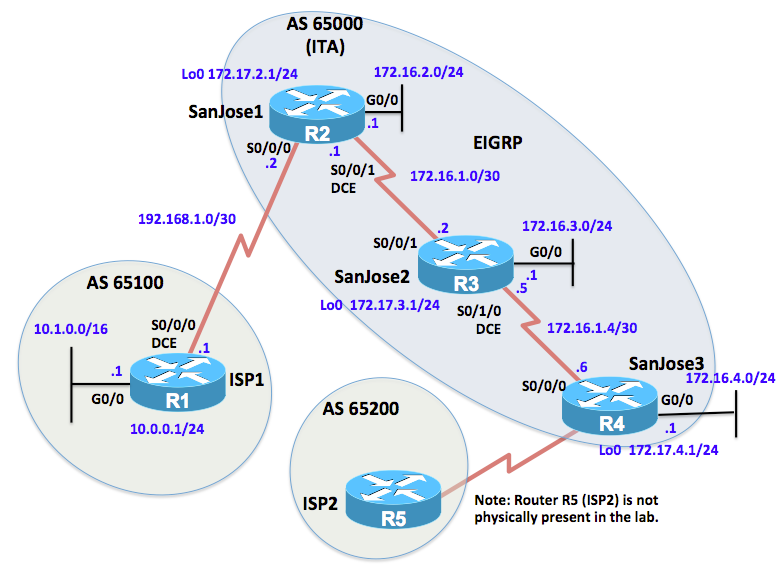
- •Verify connectivity.
- •Router r3 (hostname SanJose2)
- •Use ping to test the connectivity between the directly connected routers.
- •Step 3: Configure bgp on SanJose1 and SanJose3.
- •Step 4: Verify bgp on SanJose1.
- •Step 5: Examine and troubleshoot ibgp next hop reachability on SanJose3.
- •In routing, the term “next hop” does not always mean the next hop is a physically adjacent interface. The next hop, as in this case, can be more than one router away.
- •Step 4: Examine the behavior of bgp synchronization being disabled.
- •X best-external, a additional-path, c rib-compressed,
- •Step 5: Configure and verify full-mesh ibgp on all ita transit routers.
- •Step 6: Configure as 65000 as a non-transit as.
- •Router SanJose2 (r3)
- •Router SanJose3 (r4)
CCNPv7 ROUTE Lab 7-4, IBGP, Next Hop and Synchronization

CCNPv7 ROUTE
Chapter 7 Lab 7-4, IBGP, Next Hop and Synchronization Instructor Version
Topology

Objectives
-
Configure EBGP and IBGP .
-
Configure EIGRP in the ITA domain.
-
Troubleshoot and resolve next hop issues in IBGP.
-
Configure full-mesh IBGP to resolve routing issue within ITA domain.
-
Configure ITA so it is not a transit AS.
-
Verify connectivity.
Background
The International Travel Agency (ITA) runs BGP on its SanJose1 and SanJose3 routers in AS 65000. SanJose1 in AS 65000 is running EBGP with the ISP1 router in AS 65100. SanJose3 in AS 65000 is running EBGP with the ISP2 router in AS 65200. ITA routers need to receive IPv4 networks from both ISPs. To ensure AS 65000 is not a transit AS, SanJose1 and SanJose3 will only include ITA networks 172.16.2.0/24 and 172.16.4.0/24 in its BGP updates to the ISP routers. Your job is to configure EIGRP BGP for this internetwork.
Note: The topology shows SanJose3 in AS 65000 is running EBGP with the ISP2 router in AS 65200. ISP2 (router R5) does not actually exist in the physical lab topology. This is done due to the limitations of four routers in our CCNP NetLab topologies.
Note: This lab uses Cisco 1941 routers with Cisco IOS Release 15.4 with IP Base. The switches are Cisco WS-C2960-24TT-L with Fast Ethernet interfaces, therefore the router will use routing metrics associated with a 100 Mb/s interface. Depending on the router or switch model and Cisco IOS Software version, the commands available and output produced might vary from what is shown in this lab.
Required Resources
-
4 routers (Cisco IOS Release 15.2 or comparable)
-
4 switches (LAN interfaces)
-
Serial and Ethernet cables
Step 0: Suggested starting configurations.
-
Apply the following configuration to each router along with the appropriate hostname. The exec-timeout 0 0 command should only be used in a lab environment.
Router(config)# no ip domain-lookup
Router(config)# line con 0
Router(config-line)# logging synchronous
Router(config-line)# exec-timeout 0 0
Step 1: Configure interface addresses on all routers and EBGP on ISP1.
-
Using the addressing scheme in the diagram, create the loopback interfaces and apply IPv4 addresses to these and the serial interfaces on ISP (R1), SanJose1 (R2), and SanJose2 (R3).
Router R1 (hostname ISP1)
ISP(config)# interface Loopback0
ISP(config-if)# ip address 10.0.0.1 255.255.255.0
ISP(config-if)# exit
ISP(config)# interface GigabitEthernet0/0
ISP(config-if)# ip address 10.1.0.1 255.255.0.0
ISP(config-if)# no shutdown
ISP(config-if)# exit
ISP(config)# interface Serial0/0/0
ISP(config-if)# ip address 192.168.1.1 255.255.255.252
ISP(config-if)# clock rate 64000
ISP(config-if)# no shutdown
ISP(config-if)# exit
ISP(config)# router bgp 65100
ISP(config-router)# bgp router-id 1.0.0.1
ISP(config-router)# neighbor 192.168.1.2 remote-as 65000
ISP(config-router)# network 10.1.0.0 mask 255.255.0.0
ISP(config-router)#
ISP1 has an EBGP peering session with SanJose1. ISP1 is advertising the 10.1.0.0/16 network. A similar BGP configuration is assumed on ISP2, which does not physically exist in this lab topology.
Router R2 (hostname SanJose1)
SanJose1(config)# interface Loopback0
SanJose1(config-if)# ip address 172.17.2.1 255.255.255.0
SanJose1(config-if)# exit
SanJose1(config)# interface GigabitEthernet0/0
SanJose1(config-if)# ip address 172.16.2.1 255.255.255.0
SanJose1(config-if)# no shutdown
SanJose1(config-if)# exit
SanJose1(config)# interface Serial0/0/0
SanJose1(config-if)# ip address 192.168.1.2 255.255.255.252
SanJose1(config-if)# no shutdown
SanJose1(config-if)# exit
SanJose1(config)# interface Serial0/0/1
SanJose1(config-if)# ip address 172.16.1.1 255.255.255.252
SanJose1(config-if)# clock rate 64000
SanJose1(config-if)# no shutdown
SanJose1(config-if)#
